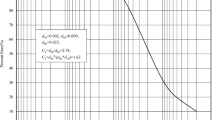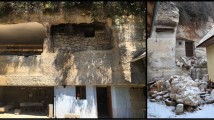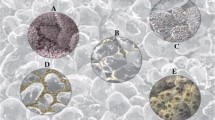Abstract
The main weathering mechanisms threatening Persepolis rocks are acid attack coming from acid rains and bio acids produced by lichens. The Persepolis complex in Fars Province, Iran is built almost entirely with two Mesozoic limestones including Dariyan and Ilam formations. The durability of limestones against acid solutions is one of the most significant factors for determining the stability of these stones in monuments. This study mainly describes the durability of these stones against acid solutions. Another purpose of this study was to evaluate the intact rock and in situ strength of limestones used in Persepolis and its quarries. For these purposes, intact rock samples from the ancient quarries of the monument were selected and their petrographic characteristics, as well as physical and mechanical properties (density, porosity, water absorption, UCS, point load strength, Brazilian tensile strength, and P-wave velocity), were determined. Then, a slake durability test was carried out, with up to 15 cycles in hydrochloric and sulfuric acid solutions. The Dariyan limestone had a lower durability index against both acidic solutions than the Ilam limestone. This is mainly due to the higher porosity and water absorption of Dariyan limestone, and the yellow gypsum-patina layer formed on this stone in the monument is another indication of its higher reaction tendency with sulfuric acid. Schmidt hammer rebound test was carried out on Persepolis limestones and fresh rocks of its ancient quarries in order to determine the strength changes in the monument stones compared to intact rocks from ancient quarries. Although both limestones showed nearly equal Schmidt hammer rebound numbers in the quarries, the Dariyan limestone in Persepolis showed lower Schmidt hammer values than the Ilam limestone. Lower strength properties and the durability of Dariyan limestone are the main reasons that have led to its higher deterioration in the monument compared to Ilam limestone.












Similar content being viewed by others
References
Aghamiri R, Schwartzman DW (2002) Weathering rates of bedrock by lichens: a mini watershed study. Chem Geol 188:249–259
Anon OH (1979) Classification of rocks and soils for engineering geological mapping. Part 1: rock and soil materials, IAEG Commission of engineering geological mapping. Bull IAEG 19:364–371
Asghari Kaljahi E, Amini Birami F (2015) Engineering geological properties of the pyroclastic cone-shaped rocky houses of kandovan. Iran Bull Eng Geol Environ 74:959–969
Ashurst J, Dimes FG (1990) Conservation of building and decorative stone, vols I and II. Butterworth, London
ASTM C830–00 (2011) Standard test method for apparent porosity, liquid absorption, apparent specific gravity, and bulk density of refractory shapes by vacuum pressure. ASTM International, West Conshohocken
ASTM D4644–04 (2004) Standard test method for slake durability of shales and similar weak rocks. ASTM International, West Conshohocken
ASTM D5731–02 (2003) Standard test method for determination of point load strength index of rock. ASTM International, West Conshohocken
Ayday C, Göktan RM (1992) Correlations between L and N-type schmidt hammer rebound values obtained during field testing. In: Rock characterization: ISRM symposium, Eurock’92, Chester, UK, pp 14–17
Aydin A (2007) ISRM suggested method for determination of the Schmidt hammer rebound hardness: revised version. In: Ulusay R, Hudson JA (eds) The complete ISRM suggested methods for rock characterization, testing and monitoring: 1974–2006. Kozan Press, Ankara, pp 25–33
Bell FG (2000) Engineering properties of soils and rocks, 4th edn. Blackwell Scientific Publishers, Oxford
Broch E, Franklin JA (1972) The point-load strength test. Int J Rock Mech Min Sci 9:669–697
Brown ET, International Society for Rock Mechanics, Commission on Testing Methods (1981) Rock characterization, testing and monitoring: ISRM suggested methods. Pergamon Press, Oxford
Calmeyer P (1990) Madjdabad. Zur Datierung von Steinbruch-Arbeiten um Persepolis, AMI 23:185–191
Charola AE (1988) Chemical-physical factors in stone deterioration. In: Rosvall J, Aleby S (eds) Air pollution and conservation. Safeguarding our Architectural Heritage, Elsevier, pp 125–132
Charola AE, Ware R (2002) Acid deposition and the deterioration of stone: a brief review of a broad topic. In: Siegesmun S, Weiss T (eds) Natural stone, weathering phenomena, conservation strategies and case studies. Geological Society, London, pp 394–406
Darvishzadeh A (2009) Geology of Iran: stratigraphy, tectonic, metamorphism, and magmatism. Amir kabir press, Tehran
Deere DU, Miller R (1966) Engineering classification and index properties for intact rock, Technical Report, AFWL-TR-65-116, Air Force Weapons Laboratory, Kirtland Air Base, New Mexico
Dreesen R, Dusar M (2004) Historical building stones in the province of Limburg (NE Belgium): role of petrography in provenance and durability assessment. Mater Charact 53:273–287
Emami SM (2010) Preliminary studies on mining methods used in Sivand quarries during the Achaemenian period in Fars province, Iran. Geol Colomb 35:175–185
Erguler ZA (2009) Field-based experimental determination of the weathering rates of the Cappadocian tuffs. Eng Geol 105:16–199
Fort R, Alvarez de Buergo M, Perez-Monserrat E, Varas MJ (2010) Characterisation of monzogranitic batholiths as a supply source for heritage construction in the northwest of Madrid. Eng Geol 115:149–157
Frank-Kamenetskaya OV, Vlasov DY, Zelenskaya MS, Knauf IV, Timasheva MA (2009) Decaying of the marble and limestone monuments in the urban environment. Case studies from Saint Petersburg, Russia. Studia Universitatis Babeş -Bolyai, Geologia 54:17–22
Ghanbari MM, Bourghaee SM, Hassani AH, Farjadfard S (2010) Effect of acid rain on environment and Persepolis archaeological zone. J Hum Environ 8:59–66
Goudie AS (2006) The Schmidt Hammer in geomorphological research. Prog Phys Geogr 30(703):718
Gupta V, Ahmed I (2007) Effect of pH of water and mineralogical properties on the slake durability (degradability) of different rocks from the Lesser Himalaya, India. Eng Geol 95:79–87
Hutchinson AJ, Johnson JB, Thompson GE, Wood GC, Sage PW, Cooke MJ (1992) Stone degradation due to dry deposition of HCl and SO2 in a laboratory-based exposure chamber. Atmos Environ 26:2785–2793
James GA, Wynd JG (1965) Stratigraphic nomenclature of Iranian oil consortium agreement area. AAPG 49(12):2182–2245
Krumbein WE, Scho¨nborn-Krumbein CE (1987) Biogene Bauschaden Anamnese, diagnose und Terapie in Bautenshutz und Denkmalpflege. Bautenschutz/Bausanierung 10:14–23
Krumbein WE, Urzi C (1991) Biologically induced decay phenomena of antique marbles-some general considerations. In: Decrouez D, Chamay J, Zezza F (eds.) Proceedings of the 2nd international symposium the conservation of monuments in the Mediterranean Basin, Genève, pp 219–235
Kryza R, Prell M, Czechowski F, Domaradzka M (2009) Acidic weathering of carbonate building stones: experimental assessment (preliminary results). Studia Universitatis Babeş-Bolyai, Geologia 54:33–36
Kucera V, Fitz S (1995) Direct and indirect air pollution effects on materials including cultural monuments. Water Air Soil Pollut 85:153–165
Livingston RA (2012) Mass balance evidence for hydrochloric acid vapor attack on the marble of the statue of Phoenicia by sea salt dechlorinization. In: 12th international congress on the deterioration and conservation of stone, Columbia University in the City of New York, 22–26 Oct 2012
Mellanby K (1991) Air pollution, acid rain and the environment, 1st edn. Springer, Netherlands
Mohammadi P, Krumbein WE (2008) Biodeterioration of ancient stone materials from the Persepolis monuments (Iran). Aerobiologia 24:27–33
Mossotti VG, Lindsay JR, Hochlla MF Jr (1987) Effect of an acid rain environment on limestone surface. Mater Perform 26:47–52
Rahmouni A, Boulanouar A, Boukalouch M, Geraud Y, Samaouali A, Harnafi M, Sebbani J (2013) Prediction of porosity and density of calcarenite rocks from P-wave velocity measurements. Int J Geosci 4:1292–1299
Reddy MM, Sherwood SI, Doe BR (1986) Limestone and marble dissolution by acid rain: an onsite weathering experiment. In: Baboiam R (ed) Materials degradation caused by acid rain. ACS symposium series, vol 318. American Chemical Society, Washington, pp 226–238
Shakoor A, Bonellis RE (1991) Relationship between petrophysical characteristics, engineering index properties and mechanical properties of selected sandstones. Bull Eng Geol Environ 28:55–71
Sharma PK, Singh TN (2008) A correlation between P-wave velocity, impact strength index, slake durability index and uniaxial compressive strength. Bull Eng Geol Environ 67:17–22
Tilia AB (1978) A survey of Achaemenian sites in the north eastern part of the Marvdasht Plain. In: Studies and restorations of Persepolis and other sites of Fars is MEO reports and memorial 17, pp 73–91
Török Á (2003) Surface strength and mineralogy of weathering crusts on limestone buildings in Budapest. Build Environ 38:1185–1192
Török Á, Přikryl R (2010) Current methods and future trends in testing, durability analyses and provenance studies of natural stones used in historical monuments. Eng Geol 115:139–142
Török Á, Vásárhelyi B (2010) The influence of fabric and water content on selected rock mechanical parameters of travertine, wxamples from Hungary. Eng Geol 115:237–245
Winkler EM (1997) Stone in architecture, 3rd edn. Springer, Berlin
Yagiz S (2009) Predicting uniaxial compressive strength, modulus of elasticity and index properties of rocks using the Schmidt hammer. Bull Eng Geol Environ 6:55–63
Zorlu K (2008) Description of the weathering states of building stones by fractal geometry and fuzzy inference system in the Olba ancient city (Southern Turkey). Eng Geol 101:124–133
Acknowledgments
The authors are grateful to Dr. Ranjbaran from Tehran University for petrological studies and his time.
Author information
Authors and Affiliations
Corresponding author
Rights and permissions
About this article
Cite this article
Taghipour, M., Nikudel, M.R. & Farhadian, M.B. Engineering properties and durability of limestones used in Persepolis complex, Iran, against acid solutions. Bull Eng Geol Environ 75, 967–978 (2016). https://doi.org/10.1007/s10064-015-0821-y
Received:
Accepted:
Published:
Issue Date:
DOI: https://doi.org/10.1007/s10064-015-0821-y




